MARIANI’S
Virtual Gourmet
September 24,
2017
NEWSLETTER
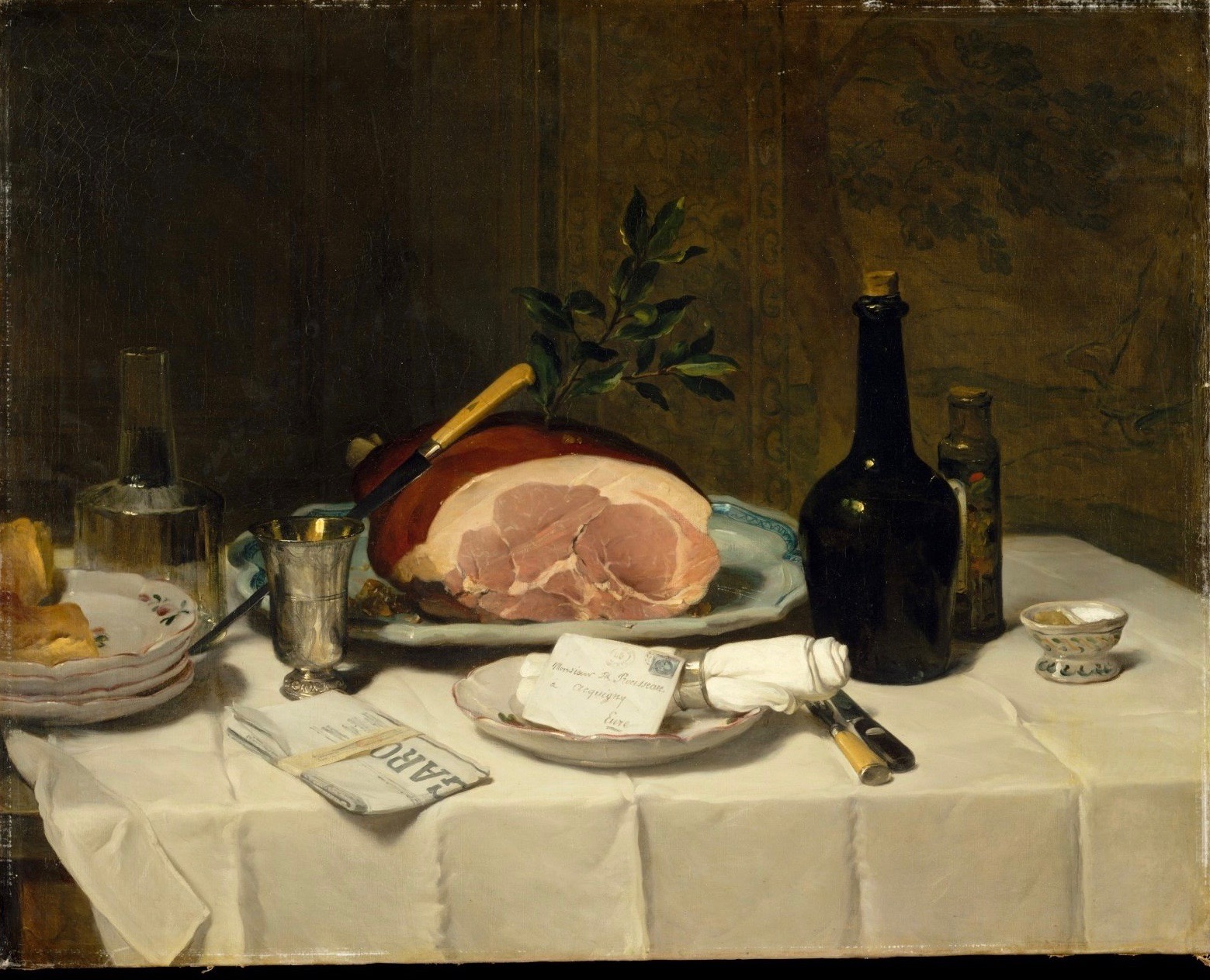
❖❖❖
PRESTIGE. LUXURY, GLAMOUR. GRANDEUR
THIS IS MONTE CARLO
By Misha Mariani
NEW YORK CORNER
MAJORELLE
By John Mariani
NOTES FROM THE WINE CELLAR
DONELAN FAMILY WINES
By John Mariani
❖❖❖
Prestige.
Luxury. Glamour. Grandeur.
This is Monte Carlo.
By Misha Mariani
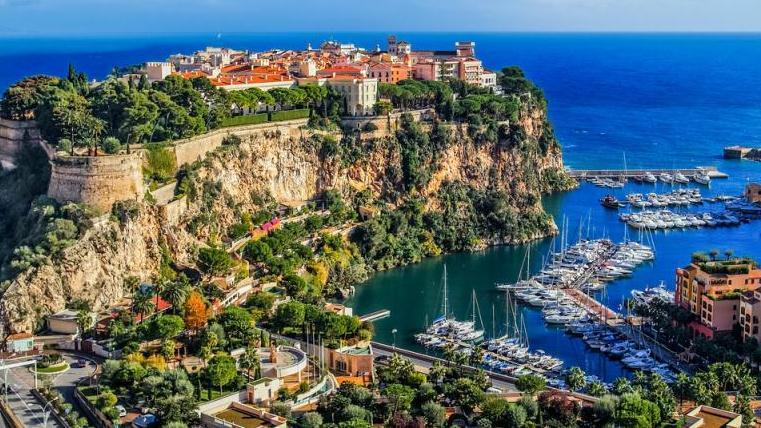
On my recent trip scouring
the Riviera, where I began in Italy and drove the
coast into France, I had the luxury of spending
two glamorous nights in Monte Carlo, a ward in the
principality of Monaco, whose history wasn’t
always as glamorous it is today. In the 19th
century, after troubled times, the principality of
Monaco lost control of two nearby towns, Menton
and Roquebrune,
which were the main providers of revenue 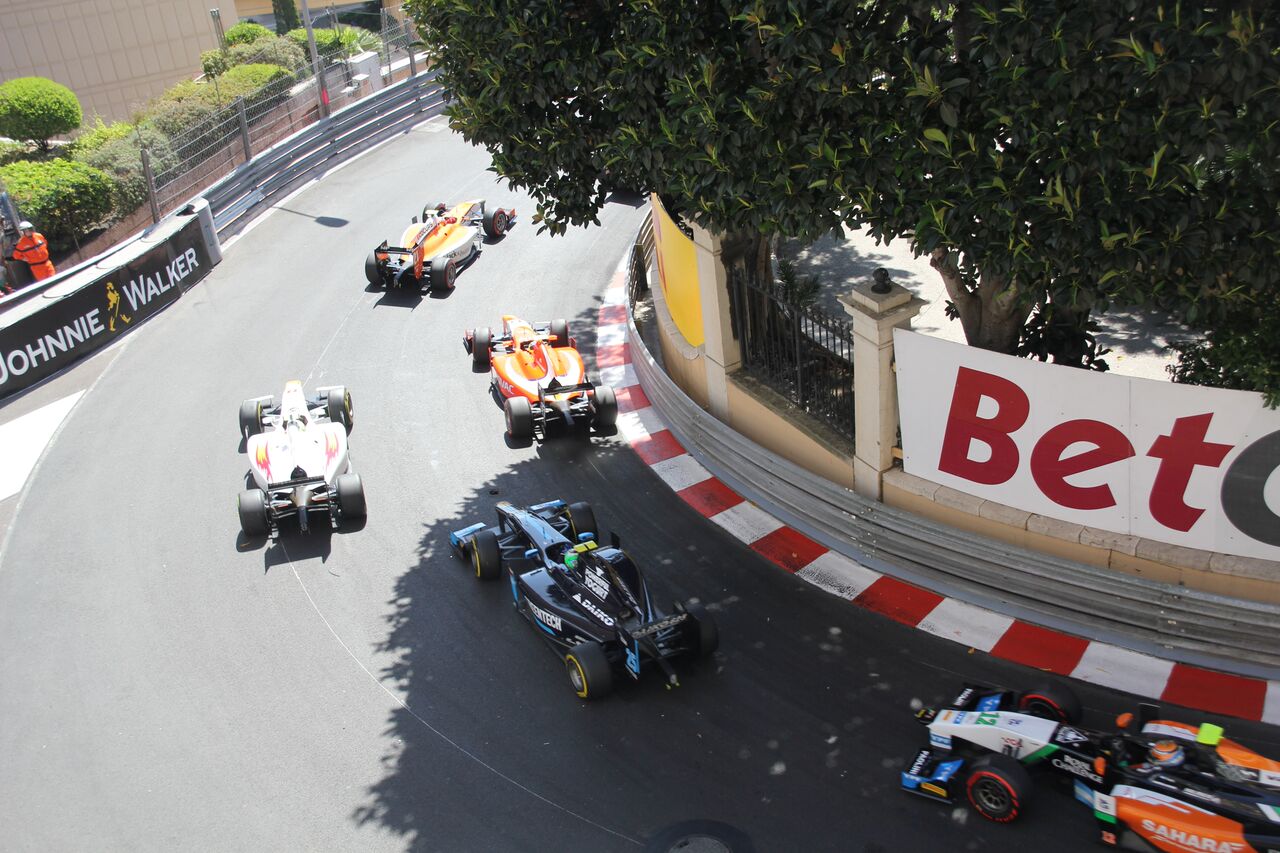 through citrus and olive
crops. On the verge of bankruptcy, they turned to
developing casinos, which at the time were showing
great returns in small towns in Germany.
This, coupled with a new railway providing direct
access from France and the rest of Europe began to
turn around the solvency of Monaco. Quickly after,
Monte Carlo became a haven for the wealthy,
powerful, influential and celebrities.
through citrus and olive
crops. On the verge of bankruptcy, they turned to
developing casinos, which at the time were showing
great returns in small towns in Germany.
This, coupled with a new railway providing direct
access from France and the rest of Europe began to
turn around the solvency of Monaco. Quickly after,
Monte Carlo became a haven for the wealthy,
powerful, influential and celebrities.
As I arrived into Monaco, hugging
the tight winding streets in my modest vehicle, I
imagined myself behind the wheel as James Bond in Goldfinger
driving an Aston Martin DB5. Now, I didn’t have an
Aston Martin that day, but if I looked in any
direction, there was a Ferrari 488, Bentley
Continental, Porsche 911 Turbo S or a Lamborghini
Huracán on the road. 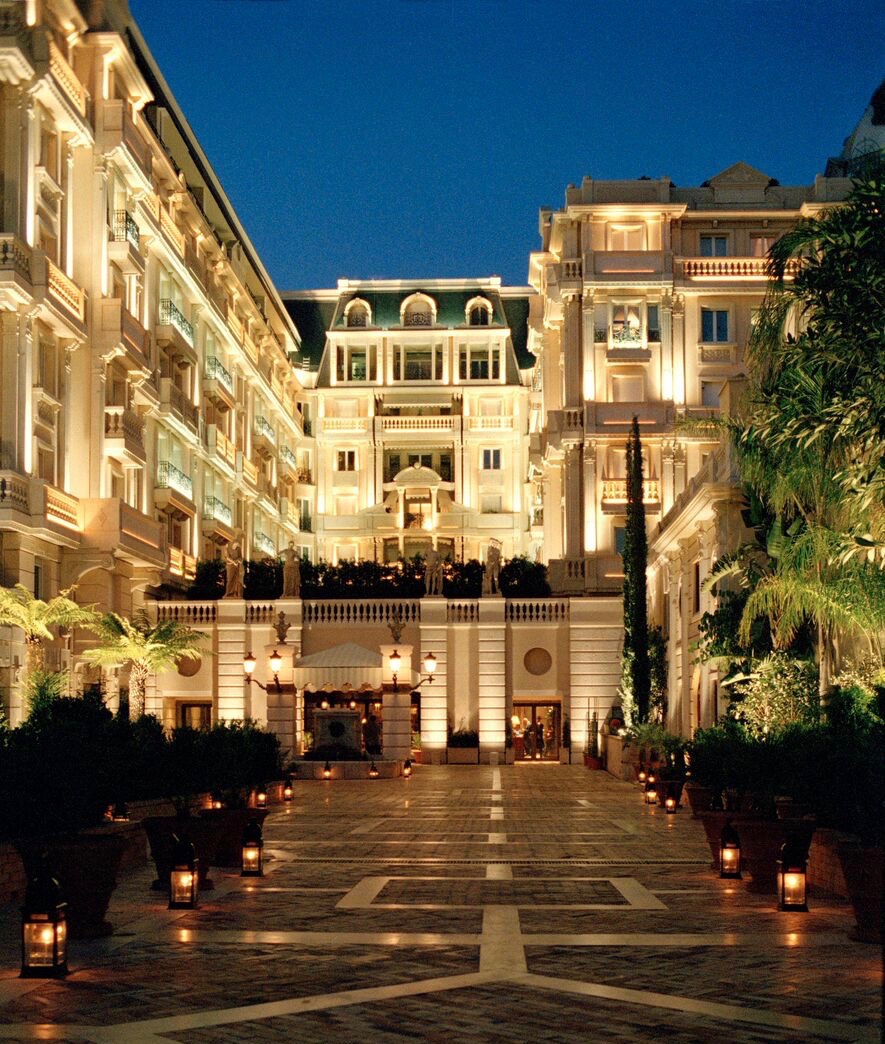
If
you
are into high-end and luxury sports cars, grab a
seat at Café de
Paris, order a martini or a beer and sit
back and watch as if you had your own personal car
show. Monaco is, of course, home to one of the
greatest Formula 1 Races, the Monaco Grand Prix.
For our two nights in Monte
Carlo, we basked in the super luxe Hôtel Metropole,
just a two-minute walk from the famous Monte Carlo Casino,
the chic Café de Paris and along Avenue de
Spélugues, where the famous Monaco Grand Prix Mirabeau corner
is located (above).
It is also in view from a number of suites within
the hotel and from the patio of Joël Robouchon’s two
Michelin Star restaurant.
Hôtel Metropole was built in 1886
and went through a full renovation in 2004.
It wouldn’t be in the spirit of Monte Carlo to be
subtle or modest, so for their renovations, they
commissioned some of the biggest names in their
fields to design what is one of the most lavish and
competitive hotels in Monaco. For the hotel’s
architecture and interiors, French designer Jacques
Garcia took a contemporary spin on the Baroque
style, all sumptuous, keeping traditional elements
like richly textured tapestry, plush fabrics, gold
trim, ornate decorative, classical portraits, deep
colored woods, and checkered stone floors.
 All this is highlighted
and complemented by his use of more modern hard
lines and brighter warm lights to add life and
energy to the rooms, not usually associated
with mid 17th
century décor. These design elements permeate
throughout the entire hotel and even into Restaurant
Joël Robuchon.
All this is highlighted
and complemented by his use of more modern hard
lines and brighter warm lights to add life and
energy to the rooms, not usually associated
with mid 17th
century décor. These design elements permeate
throughout the entire hotel and even into Restaurant
Joël Robuchon.
Hôtel Metropole also teamed up
with the German fashion designer Karl Lagerfeld,
currently the creative director for Chanel and
Fendi. Lagerfeld
was responsible for the design of their outdoor pool
area and for the restaurant Odyssey located
within (below).
The star lineup continues with interior designer
Didier Gomez in
charge of designing Robuchon’s Japanese restaurant Yoshi, as well
as the design of
the newly opened spa facility in
collaboration with House of Givenchy.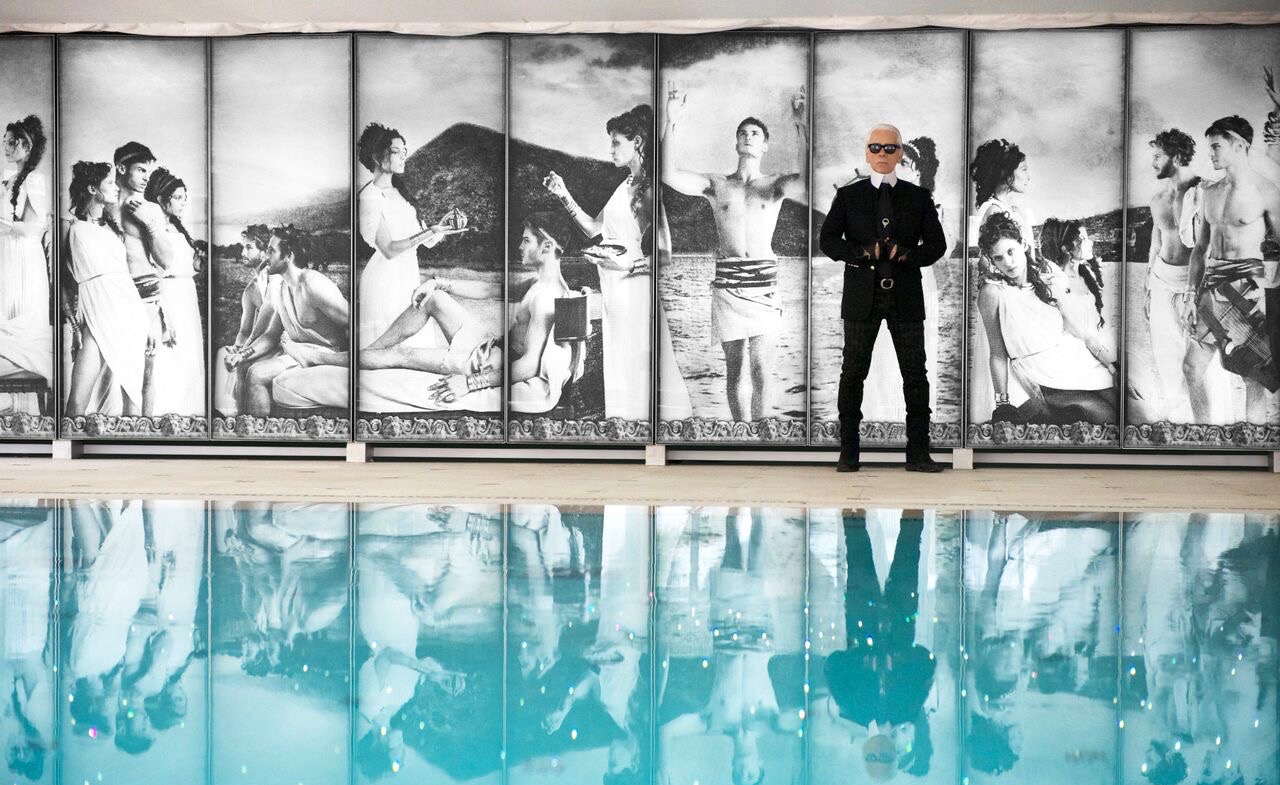
On our first night’s stay, my wife and I had the
privilege of dining at Restaurant Joël Robuchon (below), one of
four restaurants on property. Throughout,
the dining room is done in the same polished modern
baroque style of Jacques Garcia with slightly softer
tones, using dove grays, creams, light beiges, soft
ceiling-to-floor drapes, rounded pillars and open
airiness that exude an embracing welcome. In
addition to the dining room, as is a hallmark with
Robuchon, there is his chef’s counter, designed in
his trademark black and red modern motif.
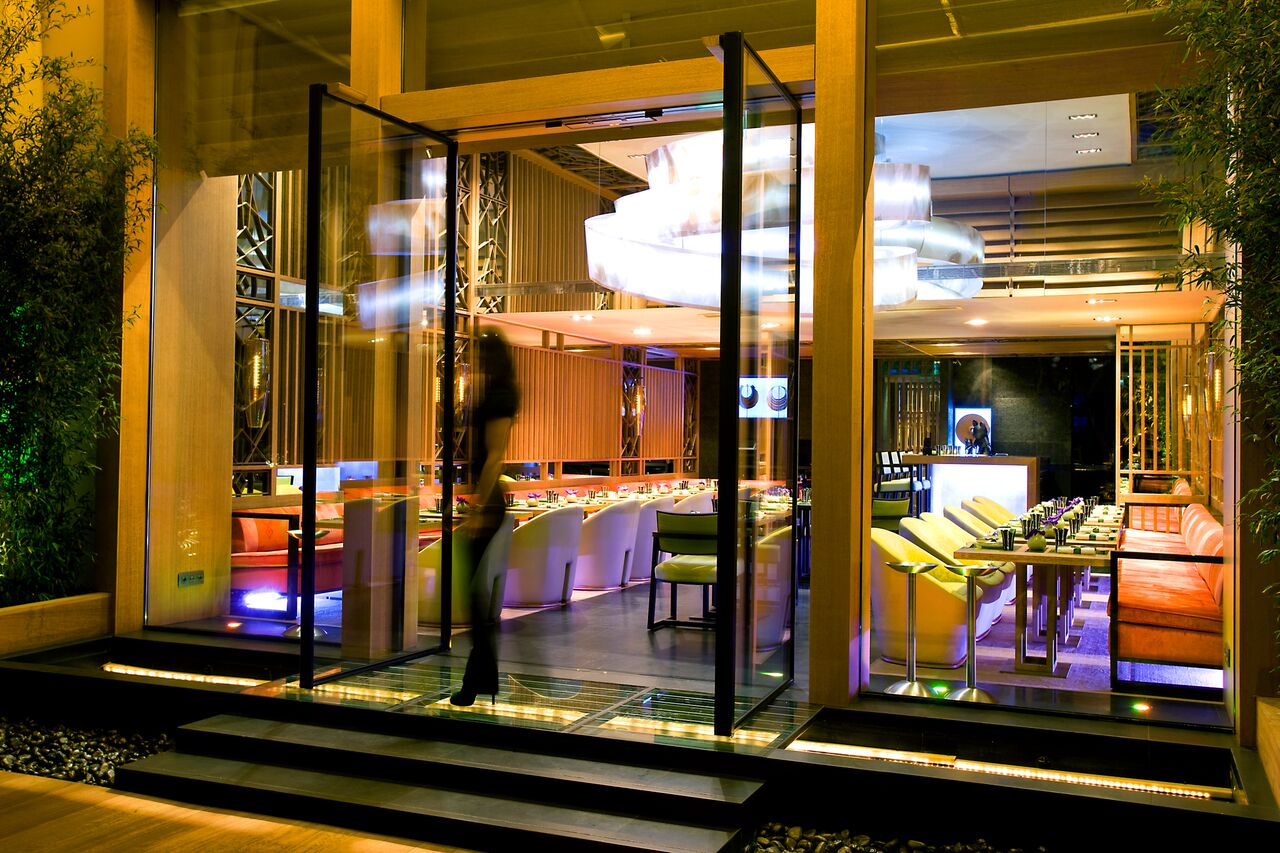 We wet our lips with a
glass of Champagne
while settling into our table outside on the patio,
taking in the sea air kissed by the setting sun and
listening to the purr of sports cars as they took
the same Mirabeau corner as those Formula 1 race
cars do every year at the Grand Prix. Before moving
into our meal, we were giddily impressed by their
bread guéridon (below),
showcasing more than a dozen breads to choose from
all baked on premises in their boulangerie.
After anxiously making our menu decision, we watched
the gentleman manning the guéridon work a quenelle
of butter to lather on some of the best bread I’ve
ever had.
We wet our lips with a
glass of Champagne
while settling into our table outside on the patio,
taking in the sea air kissed by the setting sun and
listening to the purr of sports cars as they took
the same Mirabeau corner as those Formula 1 race
cars do every year at the Grand Prix. Before moving
into our meal, we were giddily impressed by their
bread guéridon (below),
showcasing more than a dozen breads to choose from
all baked on premises in their boulangerie.
After anxiously making our menu decision, we watched
the gentleman manning the guéridon work a quenelle
of butter to lather on some of the best bread I’ve
ever had.
We started our meal with their le tourteau
releve de fines herbes e l'avocat et tomate
confit, a roulade of sweet crab meat
enhanced with confit of tomato, wrapped with creamy
avocado and accented with a touch of fresh fine
herbs (below).
My wife enjoyed a warm salad of artichokes accented
with a touch of spice of the chorizo, squid,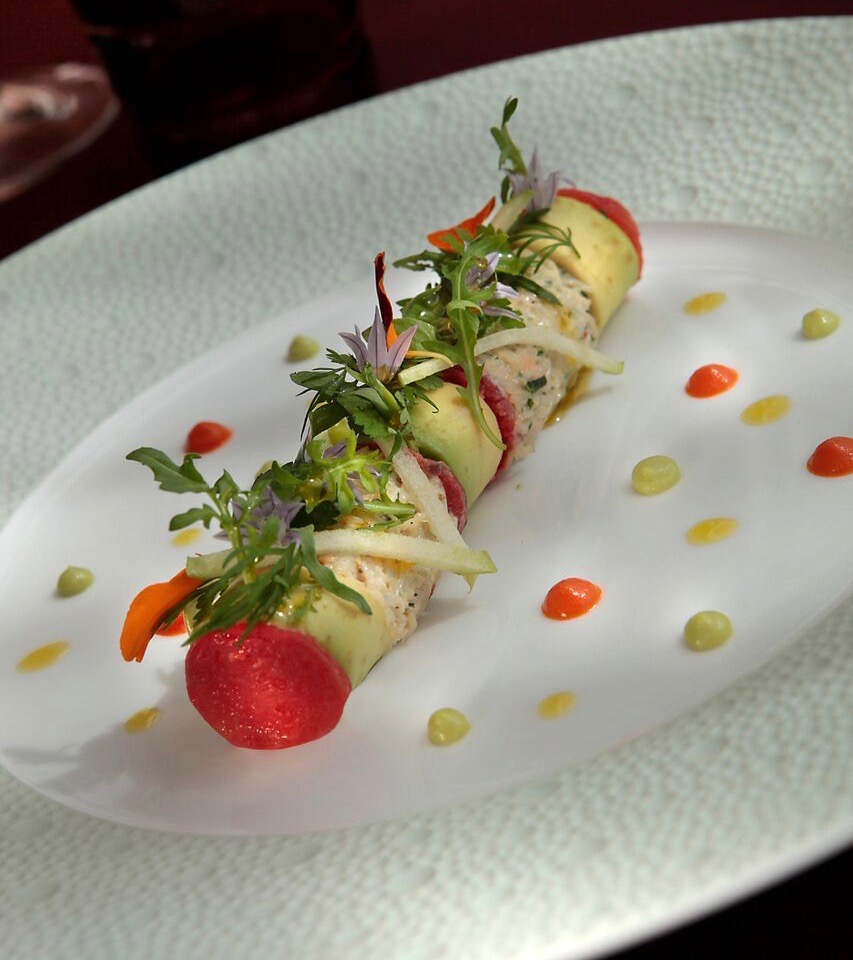 and cooked and served in
a tagine,
a dish with definite North African influence but
done with classical French technique. This was
followed by a dish of suckling pig, served simply
with pork jus
and Robuchon’s famous butter-drenched pommes purée. Perfectly
cooked filet of sole à la meunière
came with a puree of herbs, tomato confit and pine
nuts to add additional richness and texture. To
finish off our evening, similar to the bread
guéridon, a pastry cart was wheeled before our eyes.
We selected the Baba au Rhum and the classic réligieuse,
created by Carême in the 18th
century, filled with a café pastry cream and
lavished with a chocolate ganache.
and cooked and served in
a tagine,
a dish with definite North African influence but
done with classical French technique. This was
followed by a dish of suckling pig, served simply
with pork jus
and Robuchon’s famous butter-drenched pommes purée. Perfectly
cooked filet of sole à la meunière
came with a puree of herbs, tomato confit and pine
nuts to add additional richness and texture. To
finish off our evening, similar to the bread
guéridon, a pastry cart was wheeled before our eyes.
We selected the Baba au Rhum and the classic réligieuse,
created by Carême in the 18th
century, filled with a café pastry cream and
lavished with a chocolate ganache.
It was eleven o’clock and by then we were both ready to head back to our hotel room, although a night in Monte Carlo was waiting for us to explore.
Although year-around shopping,
restaurants, hitting the casino or just relaxing at
Hôtel Metropole are the main attractions everywhere
in Monte Carlo, the city is constantly putting on
seasonal entertaining events, whether it’s the Grand
Prix, Equestrian Games, kickboxing competitions or a
free citywide musical festival that happened to be
going on while we were there. Monte Carlo is
nothing short of excessive and lavish in the most
glamorous way. So if you feel like pampering
yourself and experience a stay of the likes of James
Bond, arrive in Monaco and stay at Hôtel Metropole.
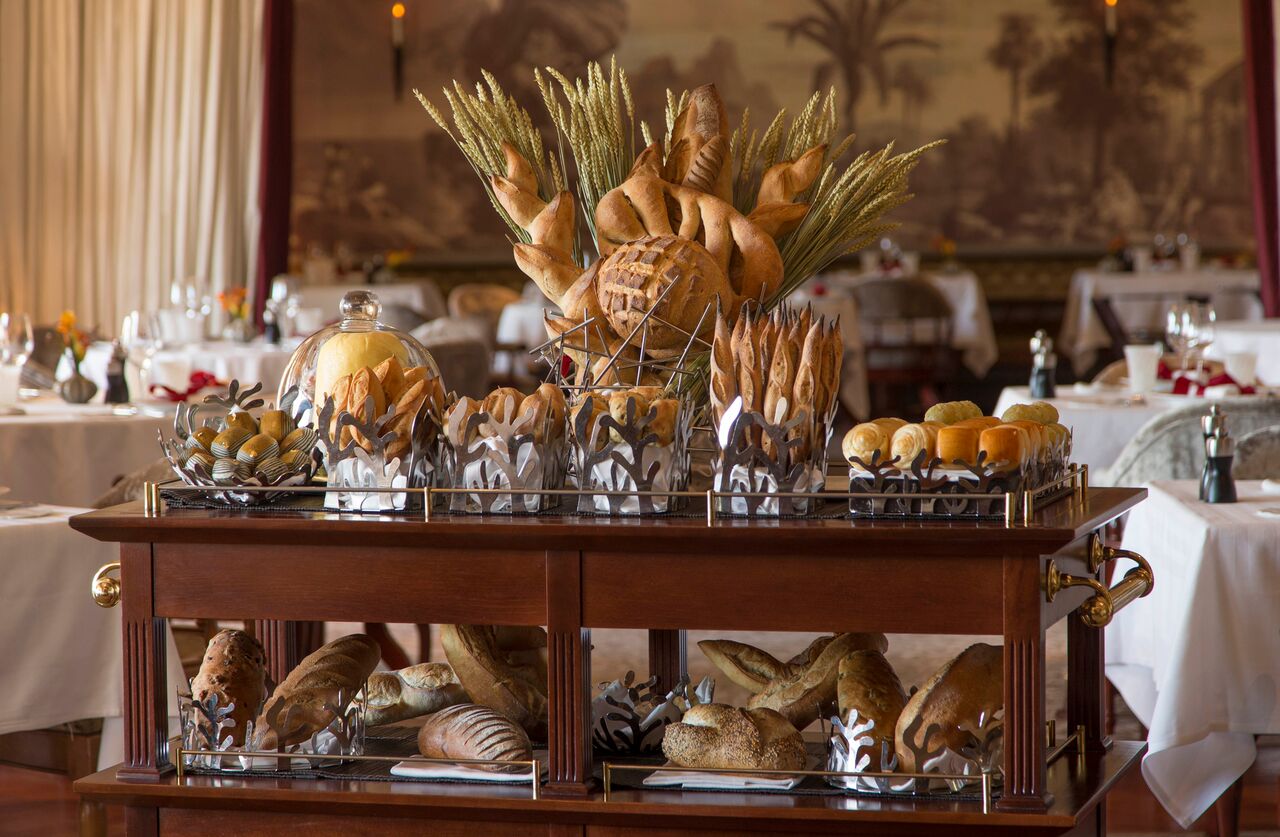
❖❖❖
By John Mariani
28 East 63rd Street (near Park Avenue)
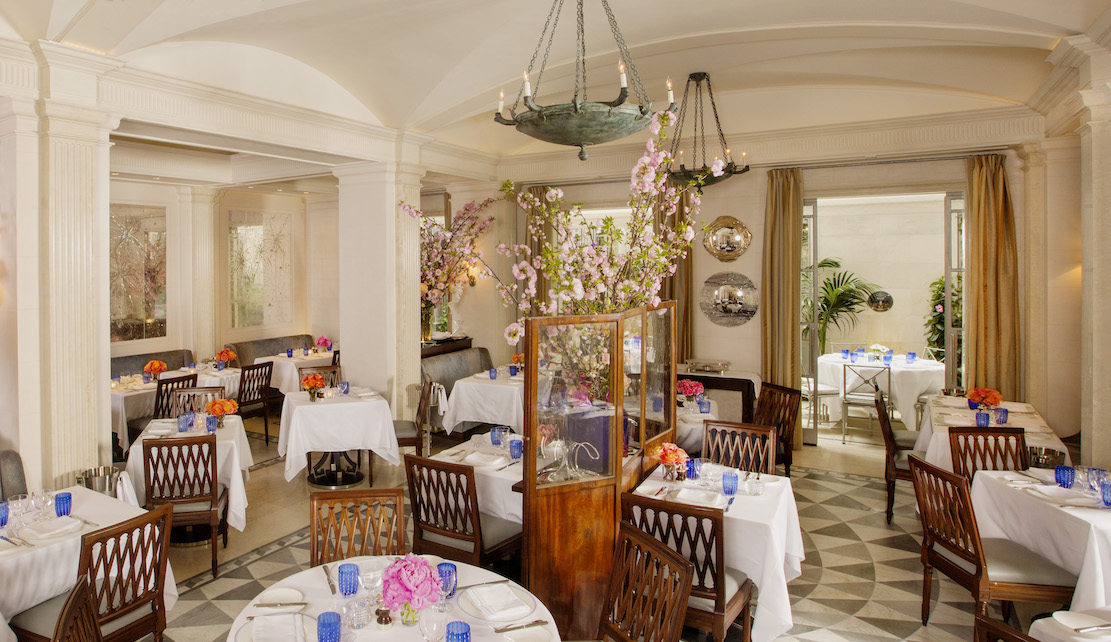
I’m happy to find
that my consistent contention that
fine dining is thriving in NYC is
borne out by the arrival of
Majorelle, not just one of the most
elegant new dining rooms but one
whose French cuisine is as classic
and contemporary as you will find in
Paris. Not that it should come as a
surprise when you learn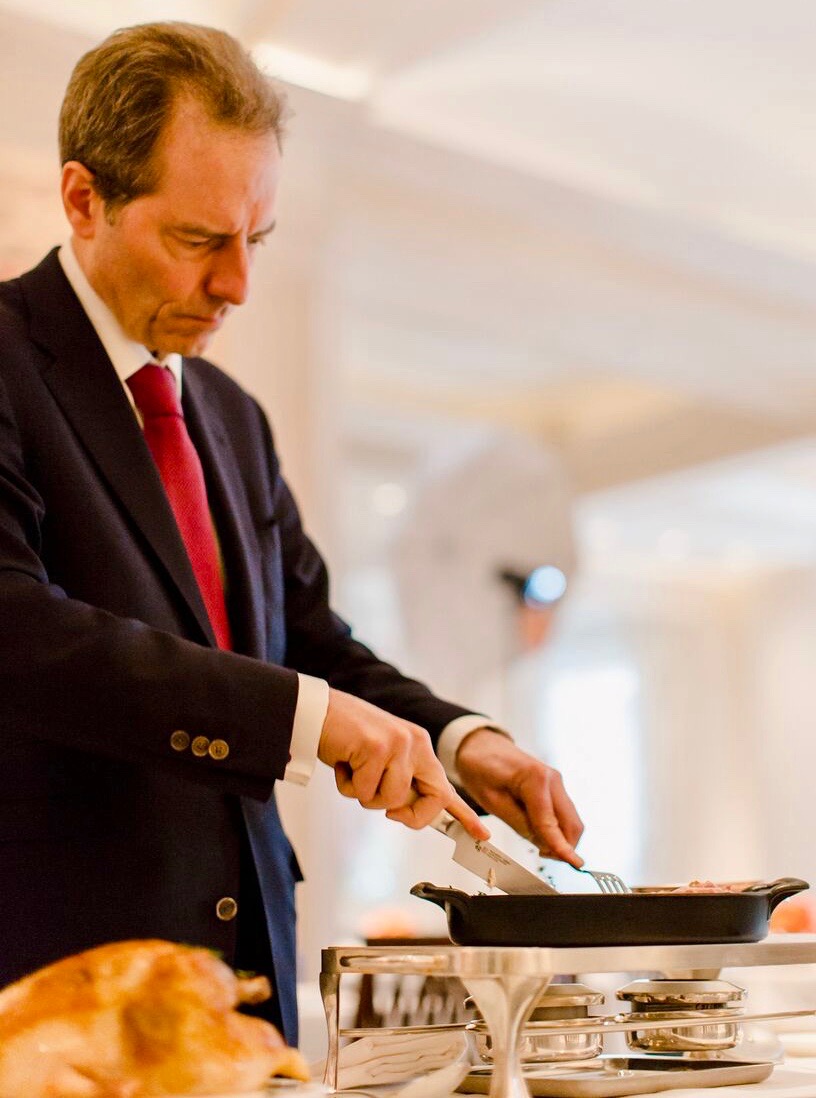 who’s overseeing and
cooking at Majorelle. Foremost in
setting the style is Charles Masson,
Jr. (left), whose long
tenure as partner and host of La
Grénouille maintained that
illustrious 55-year-old restaurant
as a bastion of good taste, even if
the menu was ever unadventurous.
who’s overseeing and
cooking at Majorelle. Foremost in
setting the style is Charles Masson,
Jr. (left), whose long
tenure as partner and host of La
Grénouille maintained that
illustrious 55-year-old restaurant
as a bastion of good taste, even if
the menu was ever unadventurous.
(Let me not waste much space on how
Charles and his brother, Philippe, parted
ways in 2014, after their mother retired
to Brittany. Whatever the reasons for the
break-up, they have affected neither
La Grénouille’s business under
Philippe’s continuance nor the flourishing
of Majorelle, which opened in May.)
Charles Masson, who had a brief stint as
general manager of the defunct Chevalier,
has settled in at Majorelle as owner and
he is always on premises to greet old
friends and new, for it was he who helped
loosen the entrenched snobbery that once
ruled NYC’s French restaurants. He is a
very gracious host, often performing
tableside duties, and he has been smart to
hire many veterans of the city’s fine
dining segment, including maître d’
Jacques Le Magueresse, formerly of Le
Bernardin, along with some young staff who
are learning the ropes of service at this
level.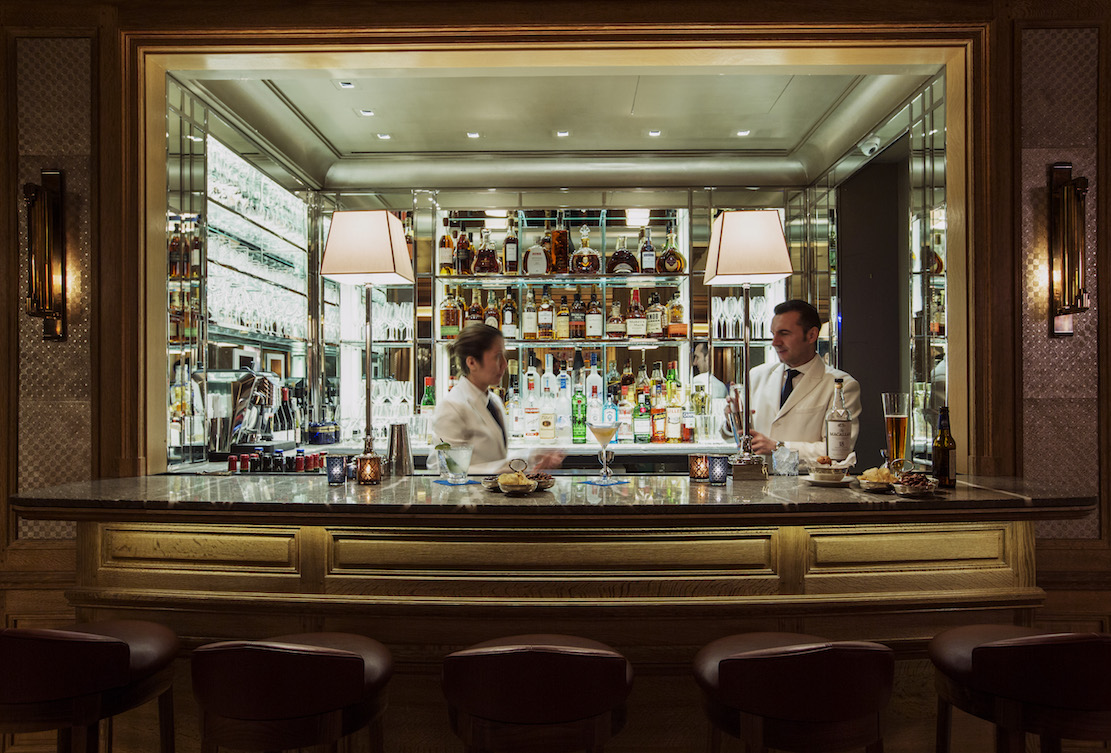
The
bisected dining room is a couple of steps
down from the handsome lounge named
Jacques (right)
and enters onto a small outdoor dining
area. All of it is suffused with light,
both day and evening, and the requisite
vases of roses for a French restaurant are
here on every table, together with cobalt
blue water glasses and first quality
linens.
The three-course dinner
is fixed at $110 (which is a far cry from
La Grénouille’s current $172), and—thank
heavens!—there are no annoying
supplements, except for American caviar
($185). The bread rolls, baked on
premises, are so good I begged for any
leftovers at the end of the night.
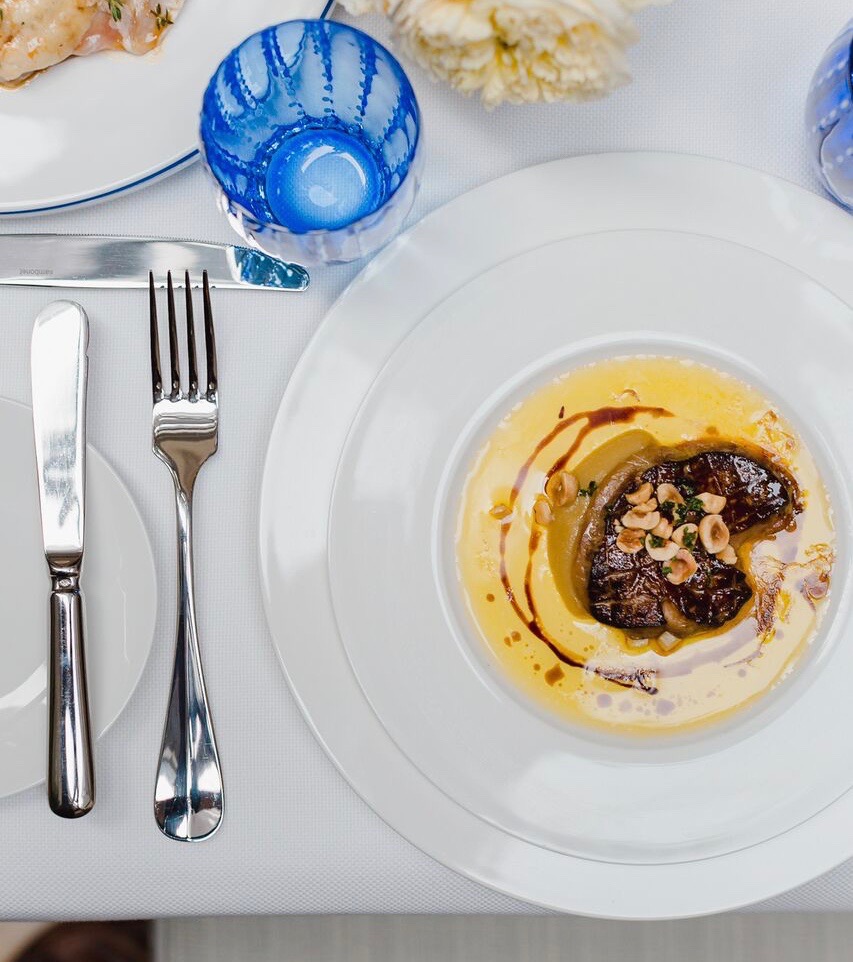 Chef
Richard Brower, whose résumé includes The
Four Seasons and Le Bernardin, shows a
light touch with the classics as well as
an affinity for dishes beyond the French
borders, as in an appetizer of carrots and
oranges braised with Moroccan spices and
served with an orange salad.
Chef
Richard Brower, whose résumé includes The
Four Seasons and Le Bernardin, shows a
light touch with the classics as well as
an affinity for dishes beyond the French
borders, as in an appetizer of carrots and
oranges braised with Moroccan spices and
served with an orange salad.
When Masson mentioned the evening’s
special was gazpacho, I winced, but he
said, “I promise you this will be a very
different gazpacho than what you’re used
to.” And it certainly was—a rich, dark red
with far more depth, reduction and
seasoning than this cold soup usually
shows. A good slice of fresh foie
gras (left)
was carefully sautéed with the sweetness
of Sauternes buoying the richness of the
dish. Brower’s saffron and lobster risotto
showed he knows how to make a risotto with
perfect texture, though it was light on
lobster flavor except for some morsels on
top.
Of the main courses there was a
fall-from-the-bone oxtail braised in red
Burgundy with shallots. A red snapper was
cooked Moroccan-style and served in a
white tagine;
with the removal of the pointed lid
releasing the aromas of lemon, fennel and
olives into the air, and the flesh of the
fish was still succulent and suffused with
spices. Lamb chops were nicely grilled and
scented with rosemary with a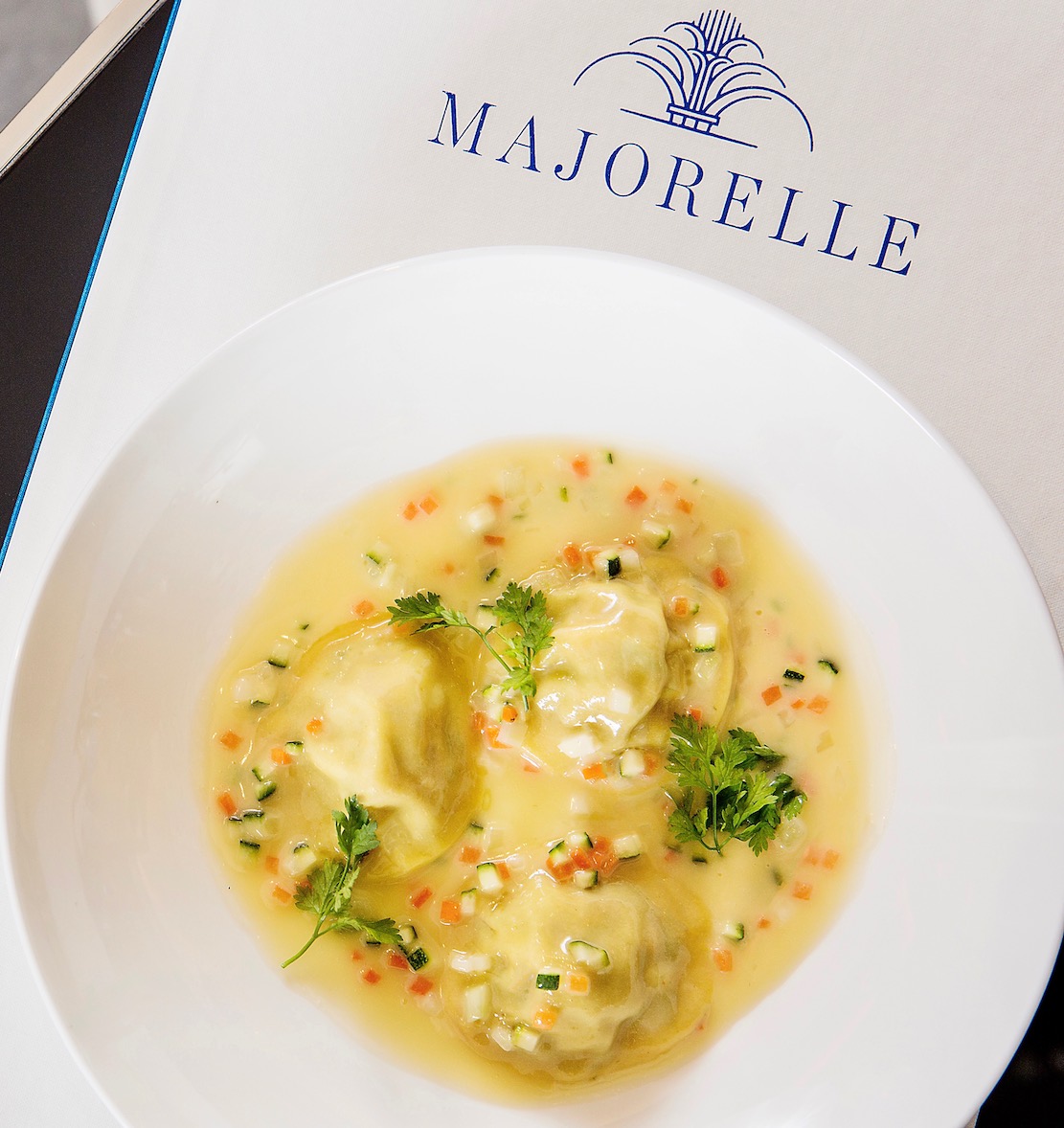 good rice pilaf studded with almonds.
Masson also persuaded me to try the
caneton à l’orange, a dish rendered so
mundane over decades of rote that I was
reluctant to do so, but it was a
revelation of just how delicious this
classic can, and should, be; served with
nutty brown rice scented with orange
blossom water, it ranks with the best duck
dishes in town.
good rice pilaf studded with almonds.
Masson also persuaded me to try the
caneton à l’orange, a dish rendered so
mundane over decades of rote that I was
reluctant to do so, but it was a
revelation of just how delicious this
classic can, and should, be; served with
nutty brown rice scented with orange
blossom water, it ranks with the best duck
dishes in town.
You must pre-order the
soufflés, which I heartily recommend. Our
pistachio version was perfect, the
puffed-up top crisp until imploded by the
insertion of a spoon into the velvety, not
eggy, interior graced with a silky crème
anglaise. Given that success, we ordered
other traditional desserts like a dark
mousse au chocolat with Grand Marnier
sauce; a baba au rhum that struck the
ideal balance of rum and vanilla
throughout the soaking sponge of the
pastry.
I’ve always been in thrall to ouefs à la
neige, with egg-shaped whipped meringues
floating in crème anglaise; at Majorelle
it is a singular oeuf as big and round as
a tennis ball, snowy white and tender,
napped with that light vanilla-rich sauce.
Majorelle seems
closer in spirit and sophistication to
contemporary Paris restaurants than to
NYC’s, and in dashing the stuffiness that
once
characterized
the “La” and “Le” dining salons of the
past, it is not only to be commended but
signals what elegant dining can and should
be in 2017.
Photos by Nico Schinco
By John Mariani
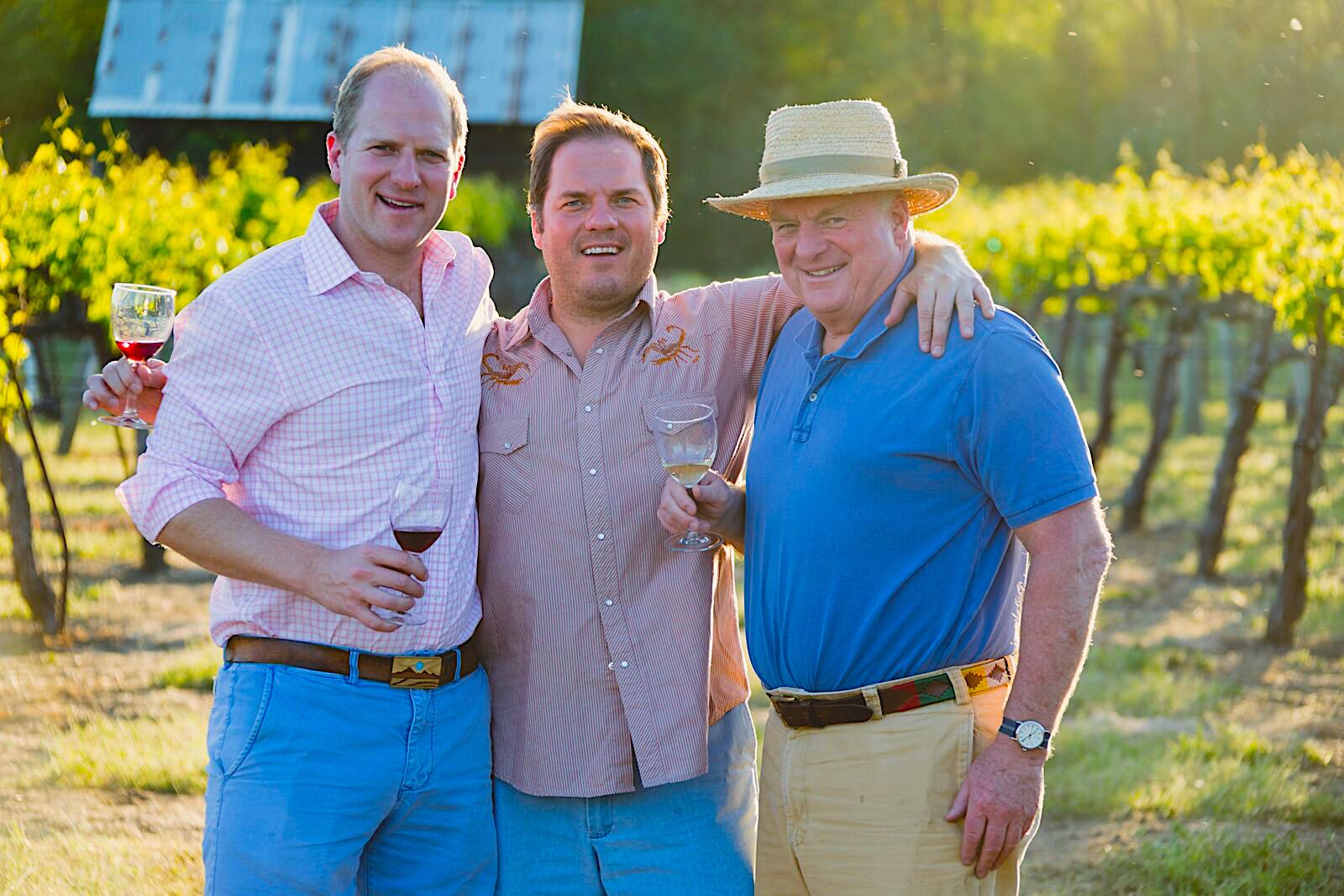
I
don’t think I’ve ever done an interview with a
California wine company executive—owner, wine
maker, marketing director—who didn’t say pretty
much the same exact things about their wines:
"We only buy the best grapes; We care deeply
about terroir; We work with and respect Mother
Nature; We have no desire to be a commercial
winery; And, our wines are expressions of
ourselves."
You’ll find the same
contentions on their websites as well as on
their back labels. I’m not often enlightened.
Cushing, Tripp and Joe Donelan
So it was an evening of refreshing conversation over dinner in New York with Cushing Donelan, Director of Marketing for Donelan Family Wines, who is as candid as he is possibly because he lives not in Sonoma but in Los Angeles. For, although he is intimately involved in the family winery, he was until 2012 an executive at actor Matthew McConaughey’s production company, and now has his own oneinarow production company. So he talks more like a Hollywood guy than a Northern California winemaker, saying things like, “Conditions in the vineyards were so good in 2007 even an untrained monkey could have made a great wine.”
Born in Connecticut, Cushing learned about wine when his father, Joe, a paper industry broker, co-founded, with Pax Mahle, PAX Wine Cellars, known for its high-end Rhône varietals. Cushing Donelan attended Amherst as a fine arts major, which led him to Southern California and into the film production industry. But his involvement with his family’s wine interests has always been intense. He joined the business in 2012, three years after the founding of Donelan Family Wines, which has sourced its grapes on long leases from cooler vineyard sites like Kobler, Richards, and DeVoto; in 2015 the family acquired Obsidian Vineyard in Knights Valley.
“It’s like real estate,” says Joe. “If you have a great location, then you should be in good shape. We believe that the best wines are not made, they are discovered. Site really trumps all variables.” Another son, Tripp, oversees all sales for the winery.
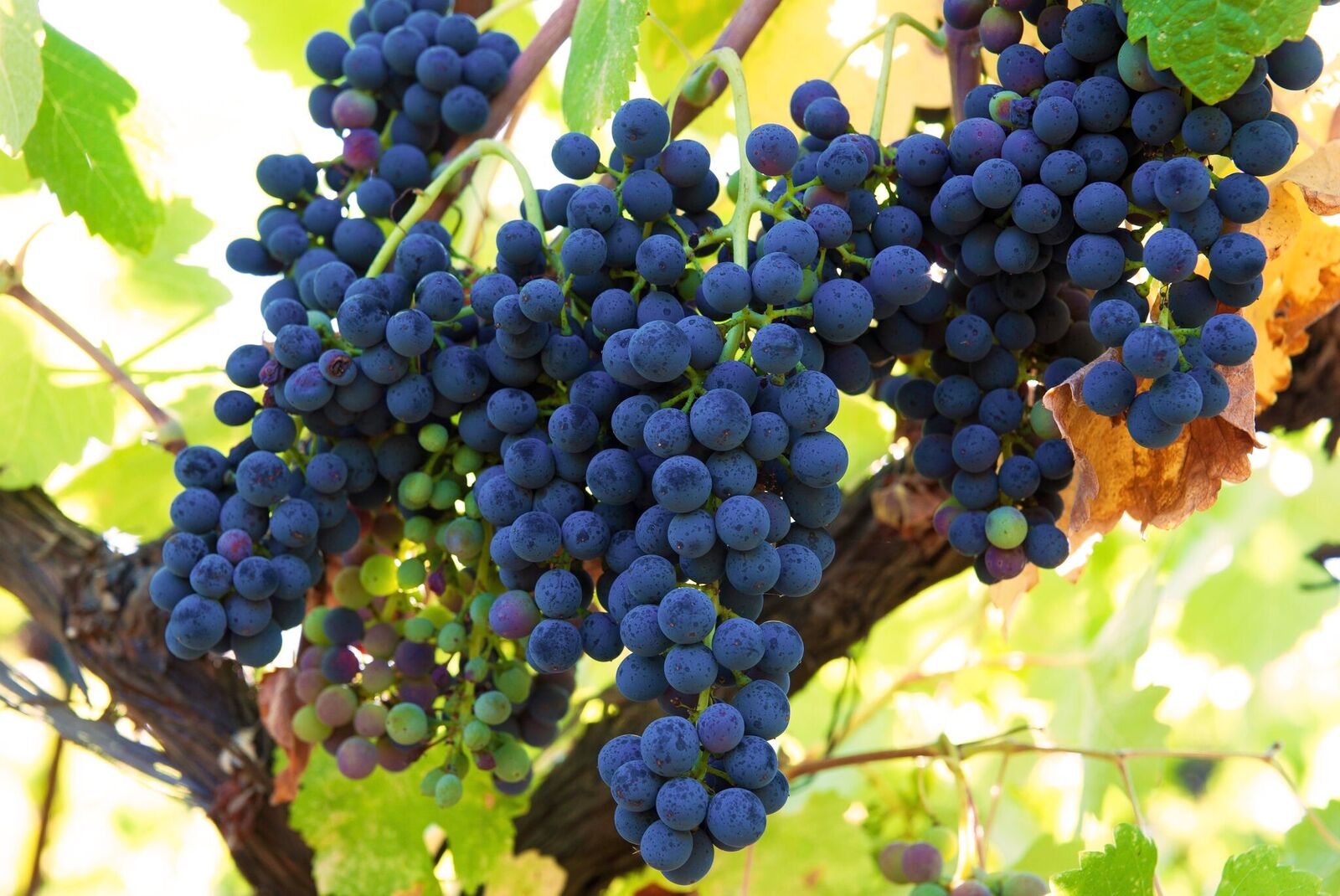 The
choice
to join the so-called Rhône Rangers, who make
Syrah (in addition to Pinot Noir, Roussane and
Viognier) was, according to Cushing, based on the
belief that, “Syrah (left) has had a couple of false
starts in California. Napa is too hot, but
The
choice
to join the so-called Rhône Rangers, who make
Syrah (in addition to Pinot Noir, Roussane and
Viognier) was, according to Cushing, based on the
belief that, “Syrah (left) has had a couple of false
starts in California. Napa is too hot, but
Sonoma is not as affected as Napa by heat. From the Obsidian site there’s little topsoil, and we get smaller clusters and therefore intensity in the fruit. We take Robert Frost’s ‘the road less traveled’ (which is also the name of their 75-minute
Tasting Tour at the winery). We don’t make those overripe Australian-style Syrahs. And we don’t make Pinot Noirs that are massive and have too much alcohol. I always say, if I can’t see through a Pinot Noir in the glass, I don’t want
to drink it.”
Cushing is frank about his competitors, and, while not naming labels, insists many of them adulterate their wines to give them body, adding juice from grapes not listed on the labels. Cite some of the biggest names in Napa, and he says flat
out, “They once made excellent
wines, now they are getting more and more
commercial.” And he waves away notions that
outrageously priced cult wines supposedly on
allocation ever actually sell every  bottle
they say they do.
bottle
they say they do.
Eighty percent of Donelan’s wines are sold through direct mailing lists and at the winery.
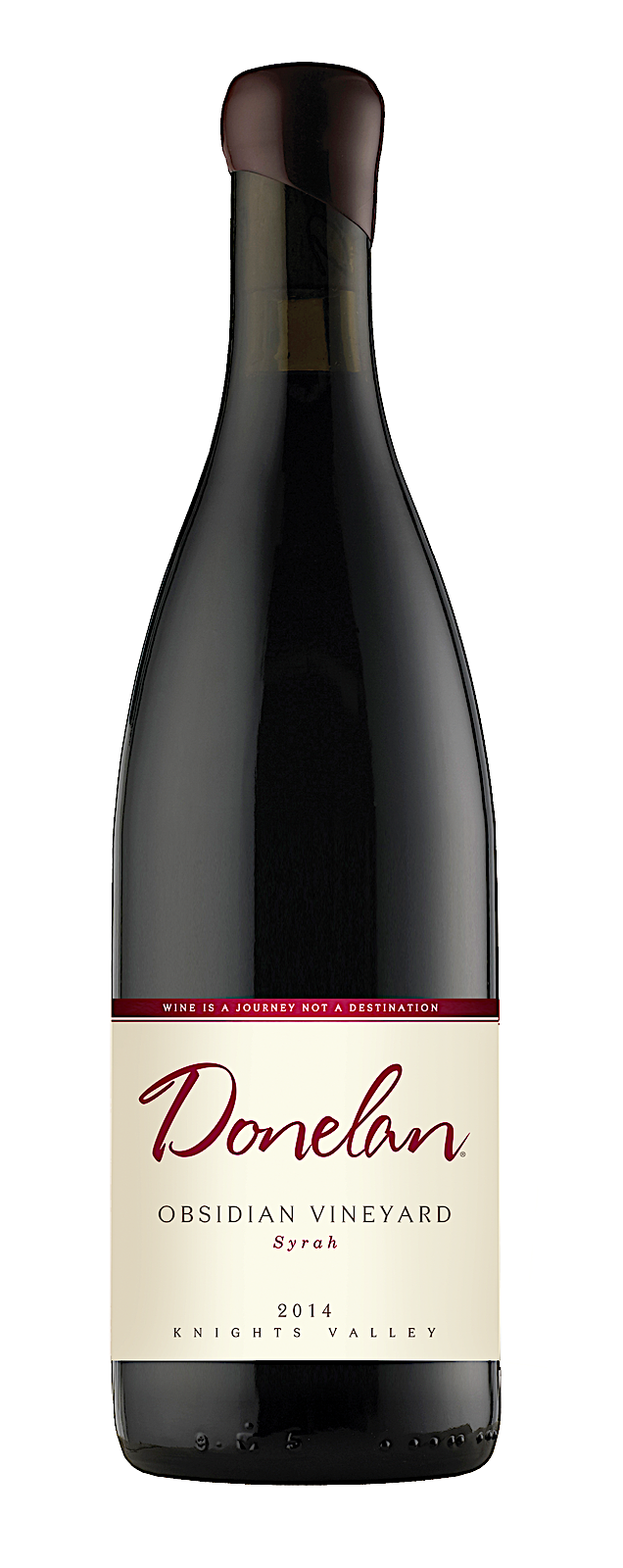 “Whether a
customer buys a bottle or several cases, he or she
can count on receiving a handwritten note from my
dad after each purchase,” said Cushing. “My father
was always a commission guy when he sold paper, so
we get a bigger cut of the sales by not going
through distributors, although we do sell 20
percent at retail or in restaurants. Our business
lives and dies by word-of- mouth.”
“Whether a
customer buys a bottle or several cases, he or she
can count on receiving a handwritten note from my
dad after each purchase,” said Cushing. “My father
was always a commission guy when he sold paper, so
we get a bigger cut of the sales by not going
through distributors, although we do sell 20
percent at retail or in restaurants. Our business
lives and dies by word-of- mouth.”
I had a chance to taste several of Donelan’s wines over a dinner of steak and lamb chops at Sparks Steak House, starting with seafood and a bottle of Nancie Chardonnay ($48), named after Joe’s mother, which showed body and fruit but had enough acid to make it ideal for lump crabmeat and shrimp in garlic sauce.
I did not love the Two Brothers Pinot Noir ($55), which, while I could see through it, I thought lacked varietal character. The Syrahs, however, were some of the best I’ve sampled from California, and the best will never be cheap. The La Cuvée Christine 2012 ($48) is Donelan’s “front line, the most value-driven wine we produce,” a blend of wines from different sources.
It is indeed a good introduction to the winery’s talent for making fine Syrah without the cloying style of so many others. Walker Vine Hill Vineyard 2013 ($75) had a much richer body, very fruit-driven but multi-layered, a delicious example of what the terroir of California soil does for the grape.
I also tasted the Obsidian Vineyard 2014 ($105), which is still tight, its tannins unyielding, so I withhold judgment until I have a chance to taste it two or even five years down the road. Right now it’s not all that it will be.
❖❖❖
THAT'LL BE
THE DAY!
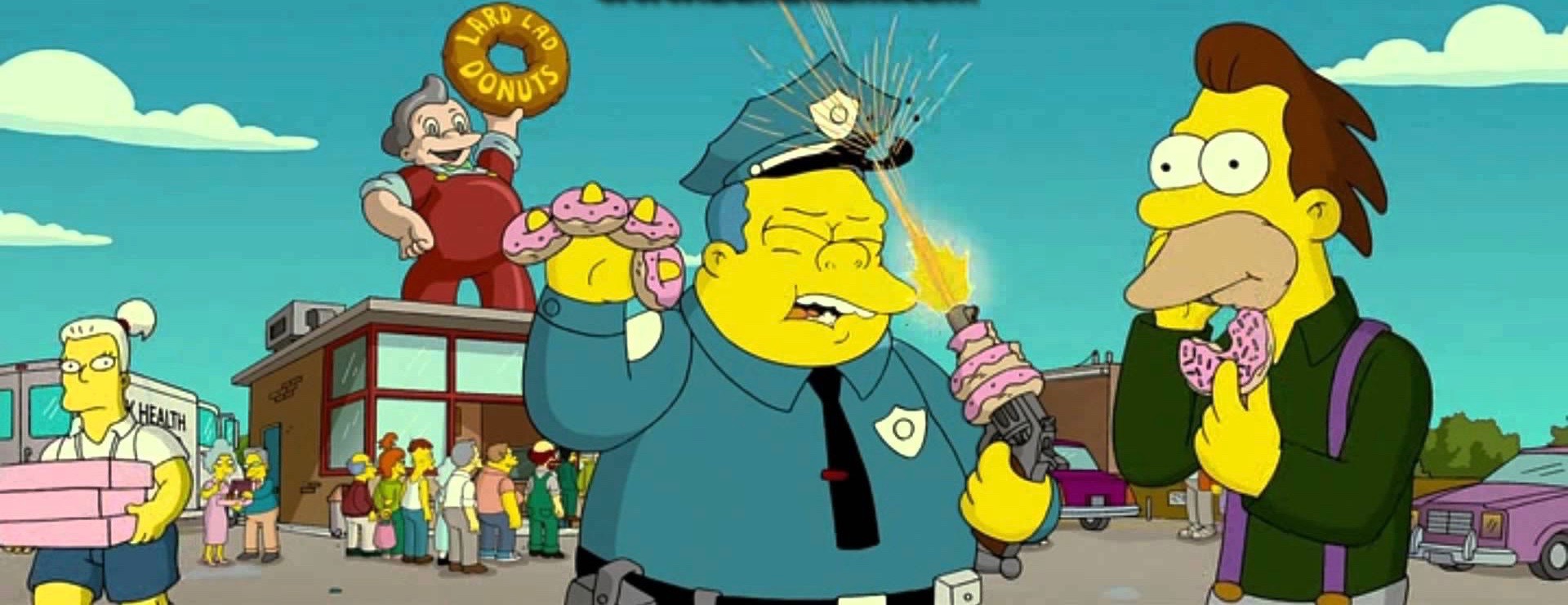 The president
of Brooklyn police labor union Detectives’ Endowment
Association, Michael Palladino, called for a
boycott of the Dunkin Donuts chain after two
plainclothes NYPD officers with visible badges claimed
they were denied service at a shop by an employee who
told them he
doesn’t serve cops. The store manager disputed the incident
but Corporate
Dunkin also issued a statement saying that the franchise owner has
personally apologized to the officers. “Our franchisees
are committed to serving each and every guest with
respect and courtesy,” the statement said.
The president
of Brooklyn police labor union Detectives’ Endowment
Association, Michael Palladino, called for a
boycott of the Dunkin Donuts chain after two
plainclothes NYPD officers with visible badges claimed
they were denied service at a shop by an employee who
told them he
doesn’t serve cops. The store manager disputed the incident
but Corporate
Dunkin also issued a statement saying that the franchise owner has
personally apologized to the officers. “Our franchisees
are committed to serving each and every guest with
respect and courtesy,” the statement said.

“Unlike SCR’s sweet-barbecue-bacon and
pico-guacamole toppings — which have become fairly
commonplace on burgers — the sriracha-and-kale combo
smacks of desperation. It reeks of a corporate attempt
to capitalize on two of the biggest food trends of the
past decade (although far after each has peaked). It’s
the fast-food equivalent of watching your Dad sport
rompers and
pledge
his undying love for Drake.”—Tim Carman, McDonald’s new
sriracha-and-kale burger is an aging hipster’s cry for
help,” Washington
Post (8/2/17).
Wine Column Sponsored by Banfi Vintners
SANGIOVESE
SEPTEMBER
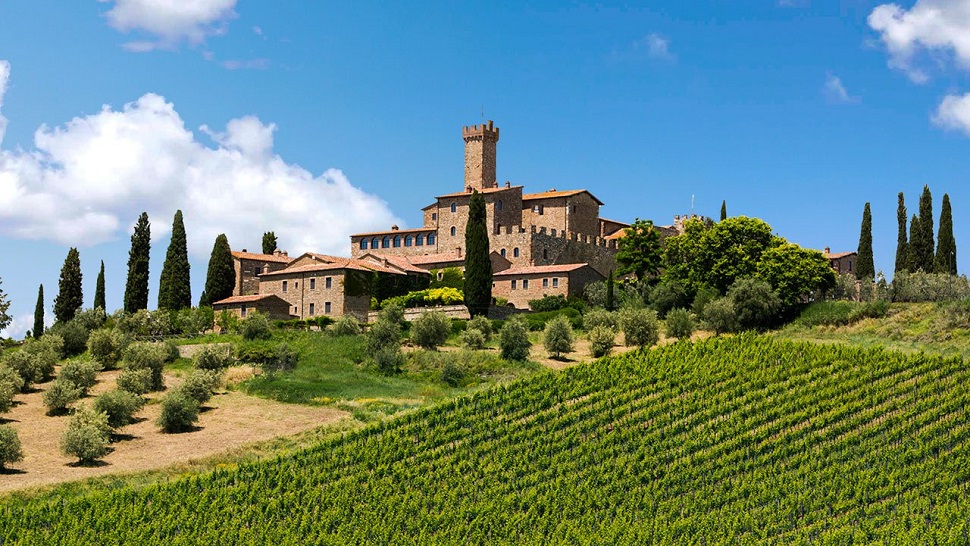 Wine
is a joy year-round but in this month in particular, one grape
varietal has really taken center stage in my daily
activities – that most Italian of grapes,
Sangiovese, and its ultimate expression – Brunello
di Montalcino.
Wine
is a joy year-round but in this month in particular, one grape
varietal has really taken center stage in my daily
activities – that most Italian of grapes,
Sangiovese, and its ultimate expression – Brunello
di Montalcino.
First,
we are approaching the days when the first
Sangiovese grapes will be harvested. From
mid-September through mid-October, the Sangiovese
grown for our various styles of red wines will be
harvested, culminating with the top selection for
Brunello di Montalcino.
Second, cooler
weather here means it is time to start enjoying more
red wines and especially Sangiovese based wines. That
includes Banfi’s cru of Brunello, Poggio alle Mura,
literally the cream of the crop of our Sangiovese
vineyards. Alongside our Poggio alle Mura Brunello
di Montalcino, this year we introduced two more
wines from the cru Poggio alle Mura – a Rosso di
Montalcino and a Riserva of Brunello. Rosso is
sort of like the younger brother of Brunello, also
made from 100% Sangiovese grapes but usually a
selection from younger vines and the wine is aged
only two years compared to the four required for
Brunello. The
Riserva, on the other hand, is an even more
selective harvest of Sangiovese, and ages for an
additional year before release.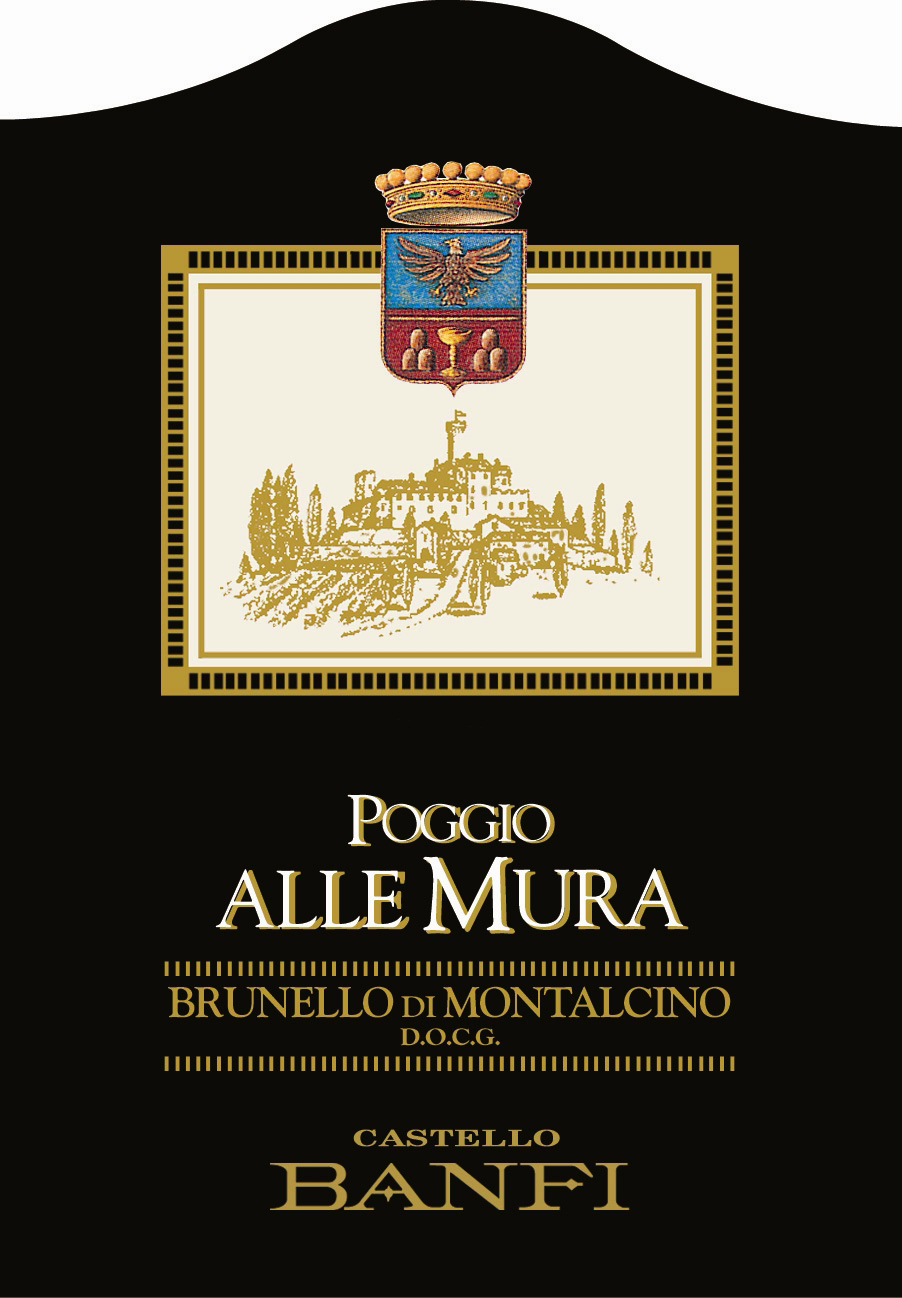
What is so special
about this cru Poggio alle Mura? Well, it
is the result our over 30 years of ongoing research
at my family’s vineyard estate, Castello Banfi. When we
first began planting our vines there in the late
1970s studies from the University of Bordeaux
indicated which strains of many varietals we should
plant, based on the soil type and microclimate of
each vineyard.
But when it came to the region’s native
Sangiovese, there was only local lore, no scientific
research. So
we took it upon ourselves to figure out this vine,
and set off on three decades of incredibly detailed
research.
We started with 600
apparent variations on Sangiovese, because it is so
susceptible to variations in weather and soil, and
narrowed that down to 160 truly genetically
different clones.
We planted a vineyard with two rows of each
type, made wine from each of them, and charted the
differences – remember, you only get one chance a
year to make wine, so this took time.
It took about ten
years to get some concrete results, though we
continue to experiment today and always will – you
never stop learning in science and nature! Once we
determined which were the best, complementary clones
that could be planted together to make the best
Brunello, we chose to plant them in what we
determined to be the optimal vineyard sites. Coincidentally,
the best soils and climate conditions are in the
slopes surrounding the medieval fortress today known
as Castello Banfi, known since Etruscan times as
Poggio alle Mura – the walled hilltop. Hence the
name of our most special “cru” of Brunello,
representing a synthesis between tradition and
innovation.
Though
the focus of this study was our Brunello, all of our
Sangiovese-based wines, including the super Tuscans
SummuS, Cum Laude, and Centine, benefited from this
work. And
that’s the third reason for celebrating Sangiovese
this month, for the range of wonderful reds that
usher us into autumn!
One wine in particular was inspired by our
research – the BelnerO, a Sangiovese dominant blend
with what I like to call a kiss of Cabernet and a
whisper of Merlot.
We grow the grapes a little differently for
BelnerO than for Brunello, make the wine with less
oak aging and released it earlier from the winery,
providing a counterpoint to Brunello and a lovely
terroir-driven wine in its own right.
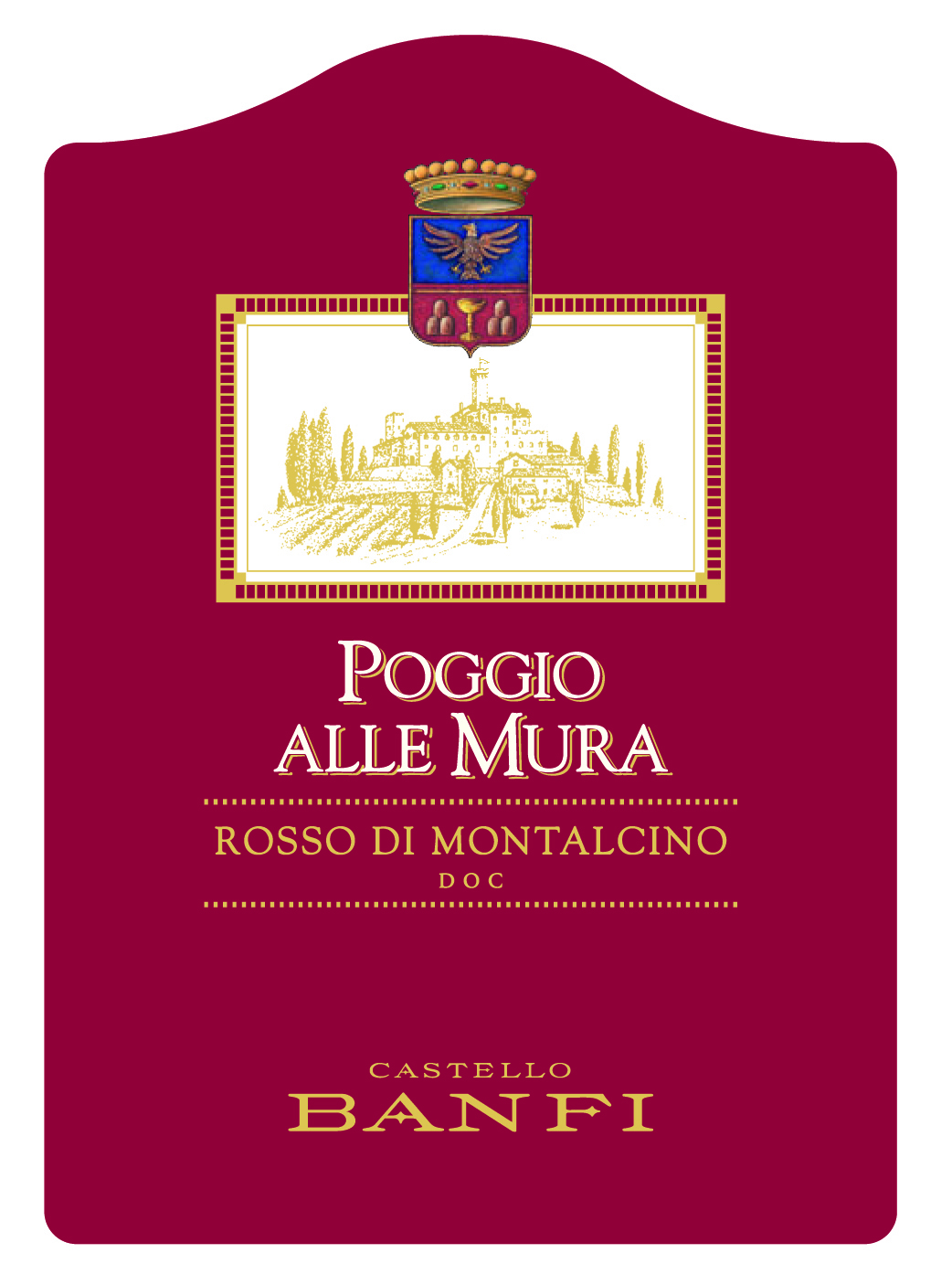 If you know Italians, you
know that by nature we are multi-faceted, varying in
mood, and always passionate. As a
nation, we span from the hot sunny beaches of Sicily
near the African coast to the rugged mountains and
Alpine ski slopes of Trentino-Alto Adige in the
north. Sangiovese
is grown in almost all of Italy’s regions and
reflects the unique nature of each; it is most
famous (rightfully so) in Tuscany, yet even there it
reflects the nuances of each hilltop, valley and
subzone. It
has something a little different to say in Brunello
than Chianti, Morellino than Vino Nobile di
Montepulciano, Rosso di Montalcino than Super Tuscan
blends.
If you know Italians, you
know that by nature we are multi-faceted, varying in
mood, and always passionate. As a
nation, we span from the hot sunny beaches of Sicily
near the African coast to the rugged mountains and
Alpine ski slopes of Trentino-Alto Adige in the
north. Sangiovese
is grown in almost all of Italy’s regions and
reflects the unique nature of each; it is most
famous (rightfully so) in Tuscany, yet even there it
reflects the nuances of each hilltop, valley and
subzone. It
has something a little different to say in Brunello
than Chianti, Morellino than Vino Nobile di
Montepulciano, Rosso di Montalcino than Super Tuscan
blends.
Here is a smattering
of Sangiovese-based wines that you may wish to get
to know better, reflecting a spectrum that appeals
to every occasion, every taste, and every budget. We can
assure you that the conversation will never become
boring.
Recommendations for Celebrating
Sangiovese
BelnerO Proprietor’s Reserve
Sangiovese – A refined
cuvée of noble red grapes perfected by our
pioneering clonal research. This dark beauty,
BelnerO, is produced at our innovative winery,
chosen 11 consecutive years as Italy’s Premier
Vineyard Estate. Fermented in our patented
temperature controlled French oak and aged
approximately 2 additional years. Unfiltered, and
Nitrogen bottled to minimize sulfites.
Castello Banfi Brunello di
Montalcino – Rich, round, velvety and intensely
aromatic, with flavor hints of licorice, cherry, and
spices. Brunello di Montalcino possesses an intense
ruby-red color, and a depth, complexity and opulence
that is softened by an elegant, lingering
aftertaste. Unfiltered after 1998 vintage.
Castello Banfi Rosso di
Montalcino – Brunello's "younger brother," produced
from select Sangiovese grapes and aged in barrique
for 10 to 12 months. Deep ruby-red, elegant,
vibrant, well-balanced and stylish with a dry
velvety finish. 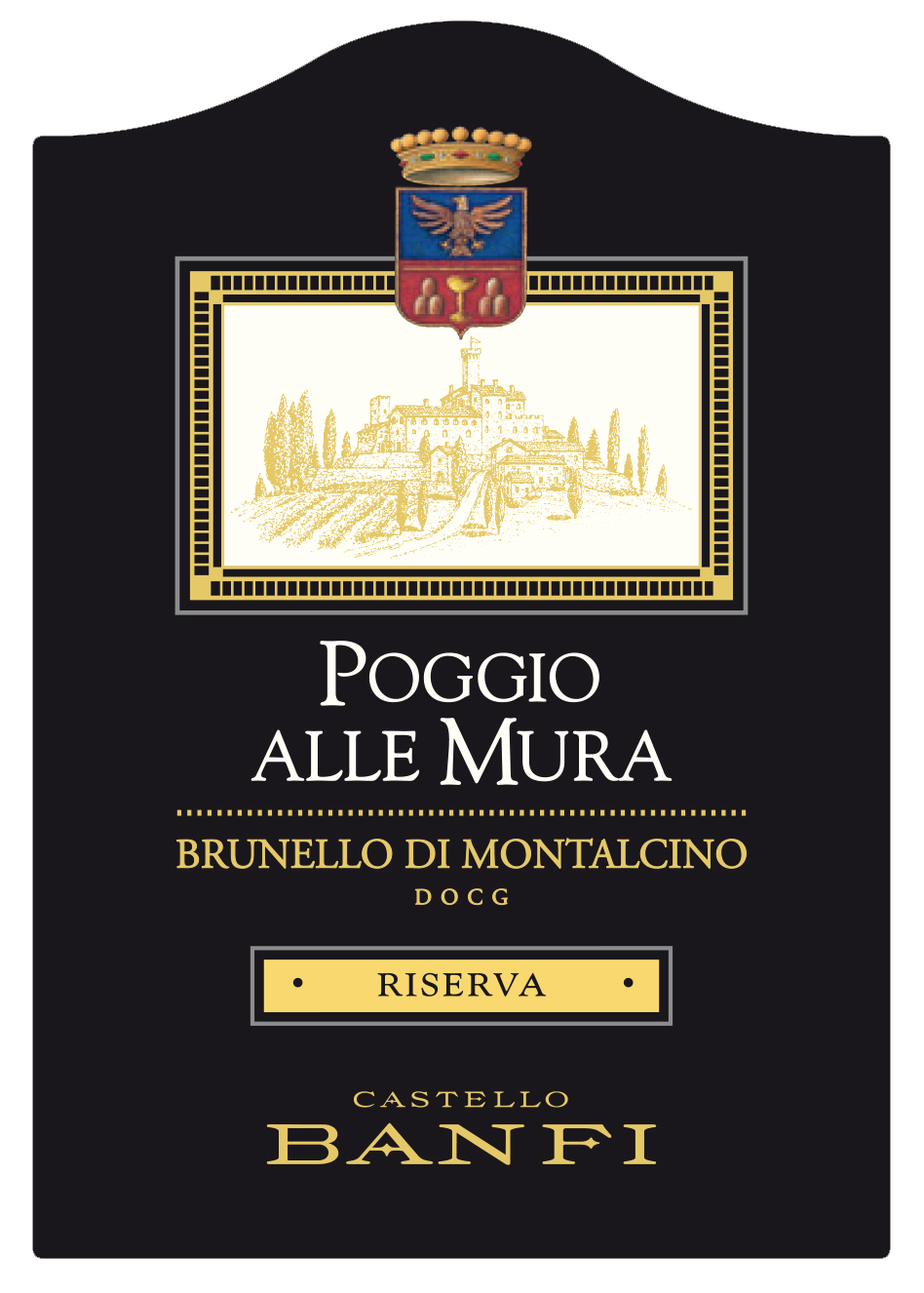
Poggio all’Oro Brunello di
Montalcino Riserva – A single vineyard selection of our most
historically outstanding Sangiovese, aged five years
before release, the additional year more than that
required of Brunello including 6 months in barrel
and 6 months more in bottle to grant its “Riserva”
designation. Incredible
elegance and harmony. Intense with lots of fruit and
subtle wood influence. Round, complete, well
balanced with hints of chocolate and berries.
Unfiltered after 1998.
Poggio alle Mura – The
first tangible result of years of intensive clonal
research on Montalcino’s native Sangiovese grape. Estate
bottled from the splendidly sun drenched vineyards
surrounding the medieval Castello from which it
takes its name.
The Brunello
di Montalcino is seductive, silky and smoky. Deep ruby
in color with an expressive bouquet of violets,
fruits and berries as well as cigar box, cedar and
exotic spices. The Rosso di
Montalcino is also intense ruby red. The
bouquet is fresh and fruity with typical varietal
notes of cherry and blackberry, enriched by more
complex hints of licorice, tobacco and hazelnut. It is
full bodied, yet with a soft structure, and a
surprisingly long finish. The Poggio alle
Mura Brunello di Montalcino Riserva is deep
ruby red with garnet reflections and a rich, ample
bouquet that hints of prune jam, coffee, cacao and a
light balsamic note.
It is full and powerful, with ripe and gentle
tannins that make it velvety and harmonious; this
wine is supported by a pleasing minerality that to
me speaks soundly of that special hillside.
❖❖❖
Any of John Mariani's books below may be ordered from amazon.com.
 The
Hound in Heaven (21st Century Lion Books)
is a novella, and for anyone who loves dogs,
Christmas, romance, inspiration, even the supernatural, I
hope you'll find this to be a treasured favorite.
The story concerns how, after a New England teacher,
his wife and their two daughters adopt a stray puppy found
in their barn in northern Maine, their lives seem full of
promise. But when tragedy strikes, their wonderful dog
Lazarus and the spirit of Christmas are the only things
that may bring his master back from the edge of
despair.
The
Hound in Heaven (21st Century Lion Books)
is a novella, and for anyone who loves dogs,
Christmas, romance, inspiration, even the supernatural, I
hope you'll find this to be a treasured favorite.
The story concerns how, after a New England teacher,
his wife and their two daughters adopt a stray puppy found
in their barn in northern Maine, their lives seem full of
promise. But when tragedy strikes, their wonderful dog
Lazarus and the spirit of Christmas are the only things
that may bring his master back from the edge of
despair. WATCH THE VIDEO!
“What a huge surprise turn this story took! I was completely stunned! I truly enjoyed this book and its message.” – Actress Ali MacGraw
“He had me at Page One. The amount of heart, human insight, soul searching, and deft literary strength that John Mariani pours into this airtight novella is vertigo-inducing. Perhaps ‘wow’ would be the best comment.” – James Dalessandro, author of Bohemian Heart and 1906.
“John Mariani’s Hound in Heaven starts with a well-painted portrayal of an American family, along with the requisite dog. A surprise event flips the action of the novel and captures us for a voyage leading to a hopeful and heart-warming message. A page turning, one sitting read, it’s the perfect antidote for the winter and promotion of holiday celebration.” – Ann Pearlman, author of The Christmas Cookie Club and A Gift for my Sister.
“John Mariani’s concise, achingly beautiful novella pulls a literary rabbit out of a hat – a mash-up of the cosmic and the intimate, the tragic and the heart-warming – a Christmas tale for all ages, and all faiths. Read it to your children, read it to yourself… but read it. Early and often. Highly recommended.” – Jay Bonansinga, New York Times bestselling author of Pinkerton’s War, The Sinking of The Eastland, and The Walking Dead: The Road To Woodbury.
“Amazing things happen when you open your heart to an animal. The Hound in Heaven delivers a powerful story of healing that is forged in the spiritual relationship between a man and his best friend. The book brings a message of hope that can enrich our images of family, love, and loss.” – Dr. Barbara Royal, author of The Royal Treatment.
 |
The Encyclopedia of American Food and Drink by John F. Mariani (Bloomsbury USA, $35) Modesty forbids me to praise my own new book, but let me proudly say that it is an extensive revision of the 4th edition that appeared more than a decade ago, before locavores, molecular cuisine, modernist cuisine, the Food Network and so much more, now included. Word origins have been completely updated, as have per capita consumption and production stats. Most important, for the first time since publication in the 1980s, the book includes more than 100 biographies of Americans who have changed the way we cook, eat and drink -- from Fannie Farmer and Julia Child to Robert Mondavi and Thomas Keller. "This book is amazing! It has entries for everything from `abalone' to `zwieback,' plus more than 500 recipes for classic American dishes and drinks."--Devra First, The Boston Globe. "Much needed in any kitchen library."--Bon Appetit. |
"Eating Italian will never be the same after reading John Mariani's entertaining and savory gastronomical history of the cuisine of Italy and how it won over appetites worldwide. . . . This book is such a tasteful narrative that it will literally make you hungry for Italian food and arouse your appetite for gastronomical history."--Don Oldenburg, USA Today. "Italian
restaurants--some good, some glitzy--far
outnumber their French rivals. Many of
these establishments are zestfully described
in How Italian Food Conquered the World, an
entertaining and fact-filled chronicle by
food-and-wine correspondent John F.
Mariani."--Aram Bakshian Jr., Wall Street
Journal.
"Equal parts
history, sociology, gastronomy, and just
plain fun, How Italian Food Conquered the
World tells the captivating and delicious
story of the (let's face it) everybody's
favorite cuisine with clarity, verve and
more than one surprise."--Colman Andrews,
editorial director of The Daily
Meal.com. "A fantastic and fascinating
read, covering everything from the influence
of Venice's spice trade to the impact of
Italian immigrants in America and the
evolution of alta cucina. This book will
serve as a terrific resource to anyone
interested in the real story of Italian
food."--Mary Ann Esposito, host of PBS-TV's
Ciao
Italia. "John Mariani has written the
definitive history of how Italians won their
way into our hearts, minds, and
stomachs. It's a story of pleasure over
pomp and taste over technique."--Danny Meyer,
owner of NYC restaurants Union Square
Cafe, The Modern, and Maialino.
|
 |
 |
 |
 |
 |
 |
 |
 |
 Everett Potter's Travel Report:
Everett Potter's Travel Report: 
 Eating Las Vegas
JOHN CURTAS has been covering the Las Vegas
food and restaurant scene since 1995. He is
the co-author of EATING LAS VEGAS – The 50
Essential Restaurants (as well as
the author of the Eating Las Vegas web site: www.eatinglasvegas.
He can also be seen every Friday morning as
the “resident foodie” for Wake Up With the
Wagners on KSNV TV (NBC) Channel 3 in
Las Vegas.
Eating Las Vegas
JOHN CURTAS has been covering the Las Vegas
food and restaurant scene since 1995. He is
the co-author of EATING LAS VEGAS – The 50
Essential Restaurants (as well as
the author of the Eating Las Vegas web site: www.eatinglasvegas.
He can also be seen every Friday morning as
the “resident foodie” for Wake Up With the
Wagners on KSNV TV (NBC) Channel 3 in
Las Vegas.

MARIANI'S VIRTUAL GOURMET
NEWSLETTER is published weekly. Editor/Publisher: John
Mariani.
Editor: Walter Bagley. Contributing Writers: Christopher Mariani,
Robert Mariani, Misha Mariani, John A. Curtas, Geoff Kalish, Mort
Hochstein, and
Brian Freedman. Contributing Photographer: Galina
Dargery. Technical Advisor: Gerry McLoughlin.
To un-subscribe from this newsletter,click here.
© copyright John Mariani 2017

